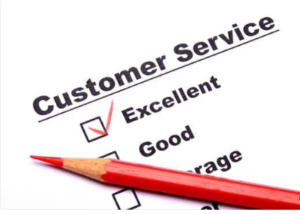Many businesses were thriving at the beginning of March 2020, before the COVID-19 pandemic forced a nation-wide shutdown that brought the economy to a grinding halt. Some industries that were already struggling, such as retail and travel, faced even more setbacks. Small businesses have been tested to limits not before imagined and are searching for ways to remain competitive with limited resources.
Before COVID-19, the digital age and launch of the internet shaped the future for how consumers do business. Millions of customers turned to online shopping in place of brick and mortar stores and shopping malls.

Big companies that didn’t evolve found themselves in trouble.
The giant video rental chain Blockbuster, with over 9,000 stores, went out of business as consumers began utilizing self-service options such as Redbox and Netflix.
The once-popular Sears Holdings (Sears and Kmart) retired over 150 stores as consumers began shopping from the comfort of their homes for day-to-day goods from clothing to bedding products.
Families began booking their travel over the internet and no longer saw a need for a travel agent.
While some major brands did not make it, other businesses pivoted and looked at innovative ways to remain in the game. The buzz words “customer experience” became all the rage with marketing and customer service-related seminars focusing on how a customer’s experience could be enhanced, allowing organizations to compete with internet shopping and delivery services.

Fast forward to March of 2020.
Some companies shut down, while others remained open with limited staffing. Owners had to make tough decisions and react with little time to evaluate the quality of customer service provided by their organizations. Many businesses experienced tremendous struggles with little to no experience responding to an international disaster, which resulted in limited inventories and resource shortages. Business owners and managers were unable to prepare their staff on handling service-related inquiries that they were not experienced in handling.
In the past few weeks, large retailers such as Nordstrom’s and Pier One have announced bankruptcy proceedings. Retailers are being added to this list almost daily.
Competing against the internet in the new normal of social distancing is beyond challenging. Still, influential leaders are watching, asking essential questions, and making the necessary changes to stay competitive and emerge stronger than before.
Are all these companies going out of business due to COVID-19 restrictions?
We’ve watched companies charge into battle and fight to remain in business so their employees can have jobs. There may be a need to adapt not only to the products and services offered to customers but the servicing of your customers.
The retail giants of the world, such as Macy’s Department Stores, have the resources to offer call centers, email customer service teams, and chatbots to customers in need of resolution. A smaller organization may not be able to provide these many options to their customers due to financial restraints and a shortage of workers.
Some of the customer service complaints as a result of Covid-19 include:
· Lack of product availability
· Limited service hours
· Delayed service times
· Poor training provided to staff
· Service-related expectations stemming from social distancing guidelines not met
· Lack of staff
· General expectations not being met

How can you truly improve upon the service that your organization is providing?
1. Evaluate what your service looks like today.
Survey both your staff and customers to determine areas for improvement.
Is it possible to move staff into different positions or adjust schedules to eliminate service gaps? If your inventory is low and on backorder, do you have a process to contact the customer when there are unexpected delays?
Step through each touchpoint to ensure there are no gaps and seek opportunities to improve.
2. Brainstorm with your staff to find better solutions.
The people on the front lines will have ideas to improve service.
Are there areas within your operations in which changes would positively impact your customers?
If call volumes are high and customers are waiting a long time when calling with a general question or problem, can you automate a call back system to eliminate the need for the customer to remain on hold? Or, should you train your team to acknowledge the long wait time and apologize for the inconvenience? Most people understand the strain on companies at this time and will appreciate the extra effort.
3. Provide education for your staff.
Make excellent customer service training a part of your onboarding process and revisit it throughout the year—plan for executing service-related improvements and implementations. Consider how possible business changes could impact your customer and how your reaction to these changes reflects on your customer’s experience. Does your workforce know what to say when there are temporary service delays? Preparing your team in advance to handle these inquires and educating your workforce on how to respond politely and with empathy can mean all the difference in your customer’s perception of your organization.
4. Monitor online testimonials regularly.
Surveys show that in this digital age, most customers look to the internet to find reviews before purchasing a new product. Several websites allow customers to provide testimonials, including Google, Facebook, Yelp, Zillow, and Angie’s List. There may be additional third-party sites relevant to your specific industry that intakes customer reviews. Your company’s customer reviews should be monitored consistently and responded to professionally immediately. The feedback may call for a need to evaluate and update processes so that future customers will have a positive experience with your organization. Ideally, collect customer feedback internally before it gets out on the web by resolving issues that, if posted, would be unflattering to your organization. Neglecting customer feedback, including criticisms, could lead to potential loss of business as prospects have this information available to them and often read customer testimonials.
5. Consider automating services.
Consider adding a Frequently Asked Questions page to your website to communicate how you do business and clear up any policy-related questions. Train your staff to refer customers to them as a resource for general information.
Consider creating a chatbot for frequently asked questions, freeing up skilled employees for more complicated inquiries. Many organizations are already implementing chatbots, and we will continue to see expansion as more businesses understand the convenience of the customer. Studies are showing that customers want answers quickly and do not mind utilizing a chat service to get immediate results. Using a chatbot now could save your organization time and operational costs in the future.
Provide an opportunity for your customers to give feedback regularly. Solicit feedback via a section of your website, an automated email, a footnote on your receipt referencing a customer service number, or even leaving a physical survey card with your customer.
Consider a small investment in a database or a third-party app that allows you to manage service-related inquiries. Your organization may want to prioritize issues, as well as quantify the number of queries you are receiving on related subjects. This information will enable you to make changes to your operations that will improve the customer’s experience based upon trends.
Many industries are going through a metamorphosis in 2020.
As customers’ needs are changing for a variety of reasons, such as a need for brands to be sensitive to anxieties over illness and financial constraints, it is necessary to implement ongoing strategies that satisfy customer expectations.
Crafting a script to show empathy towards a customer that requests a payment extension due to a job loss could result in a customer experiencing an empathetic experience. Creating a policy to address customers that are not wearing masks may service details that may create an environment in which your customers feel that your business is sensitive to the needs of others.
In looking back at the example of Blockbuster and its power at the time, Netflix evaluated the service complaints related to late fees incurred due to the customer’s busy lifestyle. They addressed these complaints and crafted their new business with services that were a better fit beginning with the mail order service that eliminated the need to inconveniently need to run out to make a return to the store. Once Blockbuster tried to match this service, not only was it too late because the customers were gone, but streaming services took over, and there was no looking back.

In the case of Sears, the pioneer of catalog and retail could have been an industry leader in online sales. Instead, they took a backseat to the online shopping forums and failed to invest in a robust inventory, durable signage, and policies that appealed to its customer base. In short, they missed the window of opportunity that could’ve inspired a generation as Amazon has!
We could look at 2020 as a gloomy year for many reasons.
Our generation has experienced life-changing events, including 9-11 and the financial crisis of 2008. These have strengthened our resolve, proved our resilience, and given us confidence that we can come out of this stronger than before.
When we pay attention to the details, remember the reasons we are in business, make necessary changes, and put our customers first, we will remain competitive for a very long time!
PaySmart provides payroll processing for small businesses. We will continue to support our clients from a holistic point of view, always putting our customers first. We will accept payroll from our clients in whichever form or fashion is right for THEM and will continue to customize our services, supporting the greater good of THEIR organizations as a customer service-centric business.
PaySmart is a payroll provider located in Mechanicsburg, Pennsylvania, supporting small businesses in the Central PA region. We are dedicated to helping small businesses take care of their payroll needs. To learn more information about how PaySmart may provide payroll solutions, please contact 717-766-1777. Our New Client Concierge is waiting for you!
